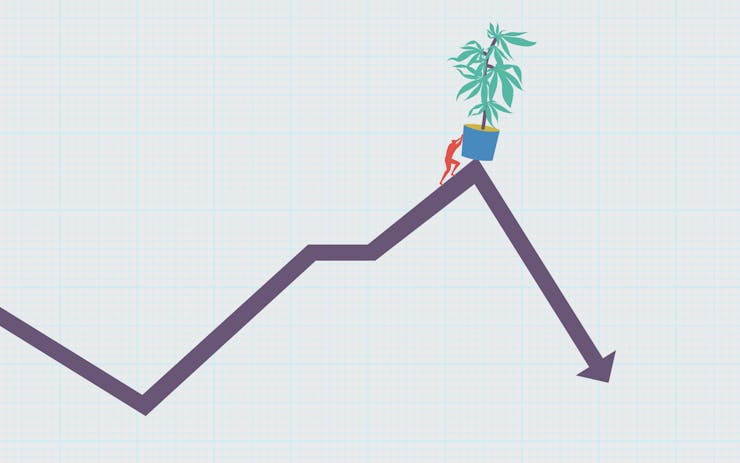It doesn’t matter if you’re a pessimist or an optimist—April has turned into one nail-biter of a month for California’s legal cannabis industry.
Facing a crash in the supply of legal cannabis, then the collapse of the nascent industry, state regulators last week reported a 100-fold increase in the monthly rate of cannabis farm licensing.
The question now is, will the new pace be enough?
No one can say, but the facts aren’t pretty.
A Great Licensing Extinction

April marks a steep decline in the amount of legal cannabis farming acreage in California. (Courtesy K Street Consulting)
As Leafly reported Feb. 25, the state’s 6,924 temporary pot farm licenses are expiring at a rate much faster than regulators have approved either permanent farm licenses—called “annuals”—or a stopgap “provisional” license type.
As of April 1, the California Department of Food and Agriculture had approved about 500 annual or provisional cannabis farm licenses. You need one of those two license types to keep farming and selling into the state’s legal system of distributors and stores.
At this pace, California might have just 1,000 to 1,500 legal farms by the end of April, when the vast bulk of temporary licenses will have expired.
“This is a crisis.”
Now, 1,000 is better than none, but it’s much less than the 6,924 farm licenses California started out with at the beginning of the year. It’s a massive culling.
“This is a crisis,” said licensing expert Jackie McGowan, at K Street Consulting.
“If something doesn’t happen, it seems our supply is essentially going to go away,” said Cody Bass, a longtime dispensary operator in South Lake Tahoe, CA, where he is also a city council member.Time to Stock Up?
Shop highly rated dispensaries near you
Showing you dispensaries nearThe Case for Optimism
A state official who spoke to Leafly on background said regulators announced “a meaningful change” on Friday that buys farm regulators enough time to fully license farms.
Basically, every farmer with a temporary license should be able to get a provisional one, so long as their annual application is completed correctly, the state official said. The policy change means the CDFA should be kicking out more provisional licenses faster.
The official said the CDFA is back-logged with about 3,300 annual applications to review, but the agency wants the industry to succeed.
The official said they expect the CDFA to be doing some “pretty amazing work on numbers” this April.

California regulators are speeding up the pace of farm licensing, but most legal farmers will still have to stop growing in prime planting season. (Leafly)
Someone’s lit a fire under the CDFA, it seems. The total number of annuals and provisionals issued climbed sharply in March — from 5 at the beginning of March to almost 500 by month’s end.
The best-case scenario is still a significant contraction in farm license numbers and diversity. Of the more than 6,924 temp farm licensees, about half might be left by May 1. Those farms might be able to grow enough cannabis to serve the state’s relatively small legal market this summer. But many experts aren’t as optimistic.
The Worst-Case Scenario
In the worst-case scenario, the CDFA licenses fewer than 1,500 farms in April, supplies drop to critical levels, prices skyrocket, and the estimated 20 percent of consumers in the legal market return to the illicit one. Voter-enacted Proposition 64 becomes a government-run failure, having regulated itself to death.
Bass and others have begun calling on Gov. Gavin Newsom to make an emergency declaration extending temporary and expired farm licenses until the CDFA digs itself out of its application review hole.
Bass said the licensing delays are costing people their businesses, their properties, their health, and fueling an illicit market that hurts public safety and the environment.
“In my mind, it’s an emergency,” Bass said.
McGowan said the industry’s best and brightest are caught up in similar licensing snafus as Bass. She also supports an executive order, saying the CDFA has proven it can’t right the ship in time.
The state official who spoke to Leafly on background said that neither an emergency declaration from the administration, nor the urgency bill—Senate Bill 67—should be needed for regulators to dig themselves out. The CDFA has the power to rapidly issue enough provisional licenses to delay judgement day, potentially forever.
McGowan disagreed: “There’s no way for the CDFA to dig themselves out of this hole in time,”
About 1,743 temp licenses have already expired this year, McGowan said, removing potentially 428 acres of pot from the supply chain. Roughly 4,000 more temp licenses expire this April.
The Next Four Weeks Are Critical
Every week, the CDFA publicly reports the number of farm licenses it has issued. If each week in April does not show several hundred or more new licensees, there could be major disruptions to the supply chain by summer.
Many legal growers will be faced with either going broke waiting for a license, or planting illegally and risking a police raid as well as loss of licensure forever. The annual outdoor cannabis season begins mid-March, and runs through October, meaning some farmers have already begun missing their spring planting window while waiting for a license.
Regardless of the future, a radical culling has already begun.
Cody Bass’ dispensary in South Lake Tahoe—Tahoe Wellness Cooperative—has been growing cannabis legally for 14 years, first under medical laws. Bass awaits an outdoor farm license from the CDFA for his plot in Mendocino County.
Due to a local issue, Bass sits at the back of the line at the CDFA, behind thousands of annual license applicants.
“I’m told I’m just completely fucked,” he said.





